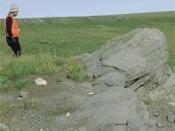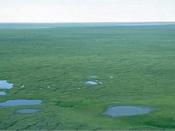The Artic National Wildlife Reserve Should Not Be Drilled for Oil
Majestic mountains dotted with ancient pines, caribou caring for their newborn calves, chirps and songs of hundreds of different birds; these are all sights and sounds that are found in the Artic National Wildlife Reserve. This reserve is truly one of America's last unspoiled landscapes, but in several years it will be invaded with oil drillers. The Artic National Wildlife Reserve does contain oil, but not enough to justify destroying America's most pristine wildernesses.
On March 16, 2005 Senate voted 51 to 49 in favor of opening the nineteen million acres of the Artic National Wildlife Reserve, also known as ANWR, for oil drilling (Kenworthy & Watson). ANWR is nineteen million acres located in the northern part of Alaska. They plan to drill 1.5 million acres of the coastal plains - the heart of the reserve. The ANWR is home to over 36 land mammals, nine marine mammals, 36 fish species, more than 180 migratory and resident bird species, and it is also serves as a birthing ground for over 130,000 Porcupine caribou (The Debate Over Oil Drilling in the Alaskan Wild"; Markey).
The history of ANWR contains members of both parties. In 1960, Republican President Eisenhower set aside the majority of the reserve, and in 1980 Democratic President Carter expanded it (Markey). In 1989, Senate proposed that part of ANWR become open to drilling, but an oil spill in Prince William's Bay prompted the bill to be dropped ("The Debate Over Oil Drilling in the Alaskan Wild"). Now, however, the rising price in oil, fifty-five dollars a barrel, has caused senators to overlook the long-term consequences of oil drilling for the short term satisfaction of oil for a few decades.
Opposition argues that oil found in ANWR will...


